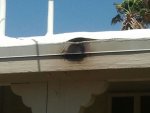If you don't understand what type of system you are dealing with and what type of hazards could be present, the best thing to do is get a qualified person on site. Assuming there is a PV array on the roof, one of the first things to check is whether the equipment is properly grounded. If not, there could be an undetected ground fault in the array. For example, perhaps a source circuit conductor is damaged and in contact with the metal roof. If so, as long as the sun is shining, the roof (and possibly the PV module frames and mounting system components) may be energized. Cutting the PV source circuit conductors doesn't necessarily change that fact, and arguably just increases the shock hazard. Depending on the type of system, there may also be other sources of voltage, such as batteries.
If the system is "unused" as suggested in the title, you might want to remove it. When removing or troubleshooting a PV system?if that's what you are dealing with?you'll need to assume that voltage is present, and conductive metal surfaces could be energized. If the array aperture are is small, you may be able to control the voltage placing a non-transparent cover over the modules. Working at night is also another option, but your work lights will still generate some voltage in the array.


